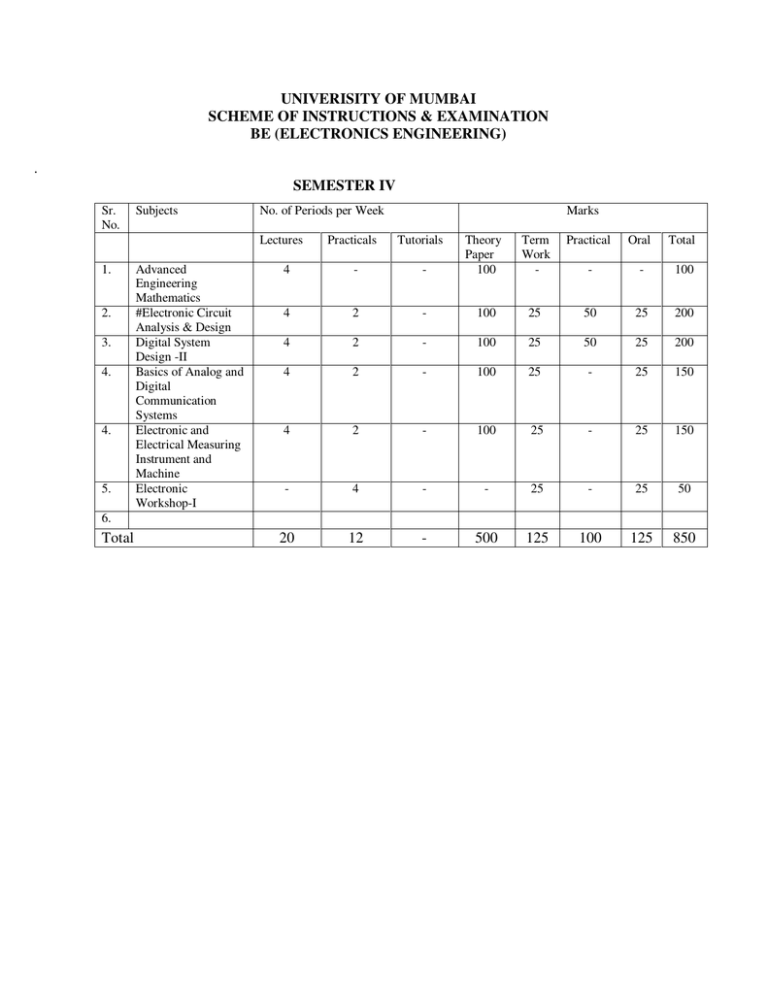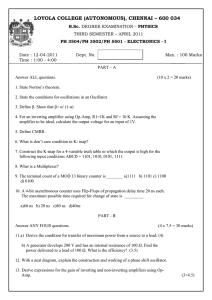Sem 4
advertisement

UNIVERISITY OF MUMBAI SCHEME OF INSTRUCTIONS & EXAMINATION BE (ELECTRONICS ENGINEERING) . SEMESTER IV Sr. No. Subjects No. of Periods per Week Lectures 1. 2. 3. 4. 4. 5. Advanced Engineering Mathematics #Electronic Circuit Analysis & Design Digital System Design -II Basics of Analog and Digital Communication Systems Electronic and Electrical Measuring Instrument and Machine Electronic Workshop-I Practicals Marks Tutorials 4 - - Theory Paper 100 Term Work - Practical Oral Total - - 100 4 2 - 100 25 50 25 200 4 2 - 100 25 50 25 200 4 2 - 100 25 - 25 150 4 2 - 100 25 - 25 150 - 4 - - 25 - 25 50 20 12 - 500 125 100 125 850 6. Total Lectures: 4 periods/week SE (ELECTRONICS) SEMESTER IV Advanced Engineering Mathematics Theory paper: 3 hours and 100 marks 1. Random variables: Lect.07 Discrete and continuous random variable probability mass and density function for random variables. Expected value, variance, moments and moment generating functions. Relation between raw and central moments. 2. Probability distributions: Lect.10 Binomial poison and normal distribution. Introduction to distribution such as ‘t’ and ‘Y’Χ2 central limit theorems and problems based on this theorems. 3. Sampling theory: Lect.08 Large and small samples, test of significance for both samples. Paired‘t’ test. Application for X2 distribution. 4. Discrete Structure: Lect.12 Reaction and function (equivalence relation, injective, subjective and injective functions). Poet, lattice (Bounded, complemented and distributive lattice). Algebraic structure, group, ring field. 5. Matrices Lect.08 Corley Hamilton theorem, eigen values and eigen vectors(without proof), Similar matrices, orthogonally similar matrices, reduction to the diagonal form. 6. Complex examples Lect.10 Cauchy’s theorem and cauchy’s integral formula, Taylor’s and laurent’s formula, singularities and poles. Residue theorem. Theory Examination: 1. Question paper will comprise of total 7 questions, each of 20 marks. 2. Only 5 questions need to be solved. 3. Question I will be compulsory and based on entire syllabus. 4. Remaining questions will be mixed in nature (for example Q2 a) from 2.1 then by will be from 4.1 or 5.1 other than 2.1. 5. In question paper weight age of each chapter will be proportional to number of respective lecture hours mentioned in the syllabus. Recommended Books: 1.P.N.Wartikar/J.N.Wartikar, Text book Applied Mathematics, Pune Vidyarthi Griha Prakashan. 2. Theory of complex variable by shantinarayan. 3. Engineering mathematics by S.S.Sastri. 4. Fundamental of Mathematical Statistics By S.C.Gupta and V.K.Kapoor. 5. Discrete mathematics by kolman, busby, Sharon rus. 6. Function of discrete mathematics by K.D.Joshi. SE (ELECTRONICS) SEMESTER IV Electronic Circuit Analysis & Design Lectures: 4 periods/week Practicals: 2 periods/week Theory paper: 3 hours and 100 marks Termwork: 25 marks, oral :25 marks Practical:25 marks Frequency Response of Amplifiers Lect.09 High frequency parameters of BJT. Amplifier frequency response, system transfer functions, SDomain Analysis. First-coder functions, bode plots, short-circuit and open-circuit time constant high frequency response of BJT, FET and MOSFET amplifier analysis. Oscillators Lect.09 Analysis and design of phase shift, quadrature, wien bridge, Hartley, colpitt and crystal oscillator. Power Amplifiers Power amplifiers, power transistors - power BJTs, Power MOSFETs, Design the class-A, ClassAL Push Pull class-B transformer coupled push pul amplifier, complementary class B Power amplifier. Heat sinks. Design heat sinks, for power amplifier devices. Differential Amplifiers BJT, FET & MOSFET differential amplifier analysis and design, design of CMOS, differential amplifier with active load (Ref: Donald Neamen). Multistage Amplifiers Design two stage BJT. JEET and MOSFET amplifiers and design of CASCODE amplifiers, design of BJT-JFET hybrid amplifier. Feedback and stability Introduction to basic feedback concepts, ideal close-loop gain, gain sensitivity bandwidth extension , noise sensitivity, reduction of Nonlinear distortion , ideal feedback topologies. Analysis of series-ghunt, series-series, shunt-shunt, shunt-series amplifiers, loop gain, stability of the feedback circuit. The stability problem, bode plots of one-pole, two-pole, and three –pole amplifiers, nyquist stability criterion, phase and gain margins, frequency compensation basic theory. Closed loop frequency response, miller compensation. Books: 1. Microelectronics circuits (Analysis and Design) by mohammad Rashid. Cengage learning. 2. Donald A. Neamen Electronic circuit analysis and design, second edition, Mcgraw Hill International edition 2001. 3. Martin Roden, Godon carpenter, William wise man, electronic design, fourth edition, shroff publishers 2002. Reference Books: 1.Donald Schilling & Charies Belove, Electronic Circuits Discrete and Integrated, Third edition, Mcgraw Hill International edition, 1989. 2.Adelsedra & Kenneth smith, microelectronic circuits, fourth edition, oxford university press, 1998. Term work: The term work shall consist of at least six laboratory experiments covering the whole of syllabus, duly recorded and graded as well as at least four computer simulations using EDA tools like PSPICE duly recorded and graded. This will carry a weightage of fifteen marks. A test shall be conducted and will carry a weightage of ten marks. Suggested list of experiments Laboratory / Simulations 1. To study frequency response of cascade amplifier. 2. To study RC phase shift oscillator and calculate threshold & practical frequency. 3. To study current series negative feedback amplifier and plot gain with feedback & without feedback. 4. To study wein bridge oscillator. 5. To study class AB and B pushpull amplifier. 6. To study Hartley oscillator. Calcultate theoretical & practical frequency. 7. To study colpitts oscillator. Calculate theoretical & practical frequency. 8. To study frequency response of two stage RC coupled amplifier. SE (ELECTRONICS) SEMESTER IV Digital Systems Design II Lectures : 4 hours/week Theory Paper: 3 hours and 100 marks Practicals: 2 hours/week Practial:3hrs.50 marks Termwork work:25 marks Oral: 25 marks 1. Hardware Description Languages Introduction to hardware description language, core features of VHDL, data types, concurrent and sequential statements, data flow, behavioral, structural architectures, subprograms, modularity, design reuse concepts. 2. Application of HDL in combinational circuits Implementation of combinational circuits n VDL, use of component instantiation and structural architecture using VHDL and PLDs combinational circuit design examplesbarrel shifter, simple floating – point encoder, cascading comparator. 3. Sequential logic design Synchronous state machine design, designing state machines using state diagrams, state reduction techniques, state assignment rules, state machine synthesis using transition lists. 4. Applications of sequential circuits MSI counters and applications, MSI SE (ELECTRONICS) SEMESTER IV Electronic and Electrical Measuring Instruments and Machines Lectures : 4 hours/week Practicals: 2 hours/week Theory Paper: 3 hours and 100 marks Termwork work:25 marks Oral: 25 marks 1. Electronic and digital voltmeters: Principles of aeration, advantages over conventional type analog voltmeters, basic voltmeter, peak reading, average reading, true RMS reading, sampling type, FET voltmeters, sensitivity considerations & calculations. Methods of analog-to-digital and digital-to-analog conversion, principles of operation and typical specifications of a digital voltmeter, description of various types of DVMs with block digital meter, digital displays for meters. 2. Frequency meters, phase meters and signal generator: Analog-schematic & operational details, limitations. Digital frequency meters, phase measurement by voltage addition method, balanced modulation type, phase meters using flip-flops, digital meters, advantages & limitations of each type. Requirement of a good laboratory type signal generator, A.F. signal generators, beat frequency oscillator & its advantages. 3. Oscilloscope: Block diagram study of C.R.O., description of panel layout & implementation of controls. Requirement of time base, triggered time base delayed time base, external triggering etc. Luscious patterns, use of these in phase & frequency measurements. Frequency time base, wobbler scope & its applications, dual trace, multi trace, double beam, sampling, storage, digital read out oscilloscopes. Use of CRO in square wave testing of amplifiers, tracing of diode & transistor characteristics. 4. Basic measuring instruments: Essentials of indicating instruments-deflecting , controlling and damping torque. Construction and working principles of moving iron and moving coil ammeters are voltmeters, electrodynamometer watt-meters, induction type energy meter power factor meters, instrument transformers. 5. Measurement of R, L and C: Measurement of low, medium, high resistances: Ohmmeter, kelvin’s double bridge, whatstone’s bridge, megger. Measurement of inductance Maxwell’s Ray’s and anderson’s bridge. Measurement of capacitance Schering bridge. 6. DC Motors: Back e.m.f. voltage equation, characteristics of series, shunt and compound motors, three point and four point starter and applications of dc motors. Three phase induction motors: Construction, working, principle and applications of variable reluctarce, permanent magnet and hybrid stepper motors. Text books: 1. Cooper w. d. & helfrick A.D., Electronics Instrumentation & Measurement techniques, third edition Prentice Hall of India,1985. 2. Kalsi H.S., Electronic Instrumentation, first edition, Tata McGraw Hill, 1997. 3. Electrical and electronic measuring instruments: A.K.Sawhney. Reference Books: 1. Electrical Measurements and measuring instruments: Golding and widdis. 2. Electric Machines: Nagrath and kothari. Termwork: The termwork should consist of at least eight experiments and three assignments covering the whole syllabus, duly recorded and graded. This will carry a weight age of fifteen marks. A test shall be conducted and will carry a weight age of ten marks. Suggested list of experiments 1. Study of during integrating DVM. 2. a. Measurement of frequency using intensity modulation. b. Design and implementation of digital phase meter. c. Design and implementation of digital frequency meter. 3. a. Measurement of frequency using luscious patterns. b. Measurement of phase difference using XY mode of CRO. c. Application of cro for component testing. 4. a. Calibrations of single phase energy meter. b. Conversion of galvanometer into ammeter/voltmeter. 5. a. Measurement of unknown resistance using kelvin’s double bridge. b. Measurement of unknown capacitance using schering’s bridge. c. Measurement of unknown inductance using anderson’s bridge. 6. a. Speed control of de shunt using armature and field control. b. Starting of three phase induction motor using auto transformer starter. SE (ELECTRONICS) SEMESTER IV Lectures : 4 hours/week Practicals: 2 hours/week Theory Paper: 3 hours and 100 marks Termwork work:25 marks Oral: 25 marks Basic of Analog and Digital Communication System Elements of Communication System: Basic block diagram of communication system, modulation and demodulation concept, channels noise in communication system, signal-to-noise ratio, noise factor and noise figure, equivalent noise temperature electromagnetic waves propagation: Propagation terms and definitions. Amplitude modulation: Principles of DSB full carrier AM, envelope detector, practical diode detector. Different types of AM: DSB-SC, SSB-SC, VSB, ISB. Angle modulation: Principles of frequency modulation and phase modulation FM modulators types of FM: NBFM and WSFM, FM transmitter, noise triangle, pre-emphasis And de-emphasis circuits. FM detection: Frequency discriminator and phase discriminator. Radio Receivers Receiver characteristics, TRE receivers and



